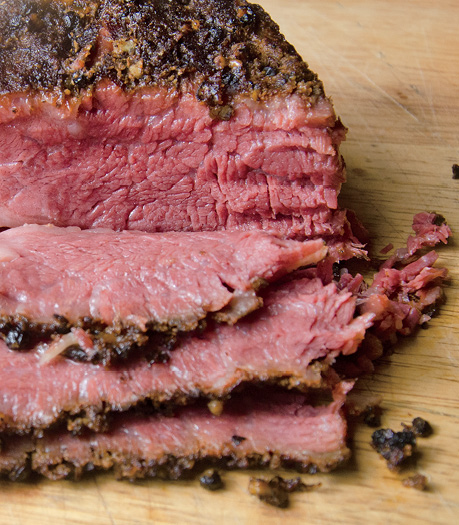
Close to Katz’s Pastrami
Pastrami is Jewish barbecue, and when made properly, it is the world’s best sandwich meat. It is essentially cured beef brisket, better known as corned beef, that has been smoked. My favorite pastrami in the world can be found at Katz’s Delicatessen in New York City. Founded in 1888, Katz’s is a timeless throwback. It has been selling smoked brisket nonstop at the same location, making it the nation’s oldest barbecue joint, although I doubt many people think of it as such. It is also where Harry met Sally’s fake orgasm, so when you go, be sure to sit at their table and have what she’s having.
Pastrami is complex and smoky, though not in the way that other smoked meats are smoky. The smoke is not overt but blended in thoroughly. The meat is highly seasoned, but the black pepper and coriander rub is never domineering, and swimming across all your taste buds are a range of other herbs and spices.
The process starts with beef brisket (some pastrami is made from a cut called navel, but I find it too fatty). The brisket is first made into corned beef by injecting or submerging the beef in a mix of salt, spices, and curing salt (see page 33). You can corn your own beef—a tricky process that takes about a week, and if you don’t do it precisely you end up throwing out the meat—or you can buy corned beef in a brine, a good one from a good butcher.
Corned beef comes in two forms: ready-to-eat and brined. Ready-to-eat corned beef is cured, then cooked, and usually packaged in slices or sliced at the deli counter. Do not use this! Brined corned beef is a hunk of brisket that has been cured in a salt solution and is usually packaged in a sturdy Cryovac plastic bag with some of the brine. It has not been cooked yet. That’s the stuff you want. I recommend corned beef from the fatty, or point, end if you can get it.

Makes about 3½ pounds pastrami, enough for 8 big deli-style sandwiches
Takes about 8 hours to soak, 25 minutes to rub, and 8 to 12 hours to smoke
- 4 pounds uncooked high-quality corned beef
- ¼ cup coarsely ground black pepper
- 2 tablespoons ground coriander
- 1 tablespoon brown sugar
- 1 tablespoon paprika
- 2 teaspoons garlic powder
- 2 teaspoons onion powder
- 1 teaspoon mustard powder
- Rye or pumpernickel bread, mustard or Thousand Island dressing, sauerkraut, and Swiss cheese for serving
1. Prep. Trim all surface fat and then put the corned beef in a nonreactive pot and cover it with cold water. Refrigerate for at least 8 hours. This removes excess salt. You need to do this or you will be gulping water all night after the meal. If you can, change the water once or twice.
2. Remove the beef from the water. Blend together the spices and apply the rub liberally, about ¼ cup per square foot of surface. Lay it on thick. Press the rub into the surface to help it adhere.

3. Fire up. Get your smoker up to 225°F or set up the grill for two-zone cooking and shoot for about 225°F on the indirect side. Add wood for smoke. If you can, use a charcoal smoker. It produces a deeper, darker crust than any other cooker.
4. Cook. Smoke the meat fat side up over indirect heat until it reaches 203°F. Add wood when the smoke dwindles. It can take 10 hours or more depending on the thickness. Don’t try the Texas crutch because it can wash off a lot of rub and smoke. At this stage, you can serve it, or some folks like to steam it to make it more tender (see page 265).
5. Serve. Slice the pastrami across the grain just like you would a brisket (see page 262). Don’t try to slice it with a machine. It will just fall apart.
6. Serve it on rye bread or pumpernickel with a schmear of mustard. Better still, toast the rye, take one slice and set it aside, and spread some Thousand Island dressing on the other slice. Pile the meat on the dressing, then top with a layer of crunchy sauerkraut from the refrigerator section of the grocery store (not the canned stuff), lay a slice of Swiss cheese on top, and stick the whole thing under the broiler to melt the cheese. Finally, put on the other slice of bread, unhinge your jaw, and enjoy the best sandwich on earth, the pastrami Reuben (Reubens are usually made with corned beef, but this is better).
7. If you have leftovers, wrap them in foil and refrigerate. You can keep them for up to a week if you wish. Bring them back to life by steaming.